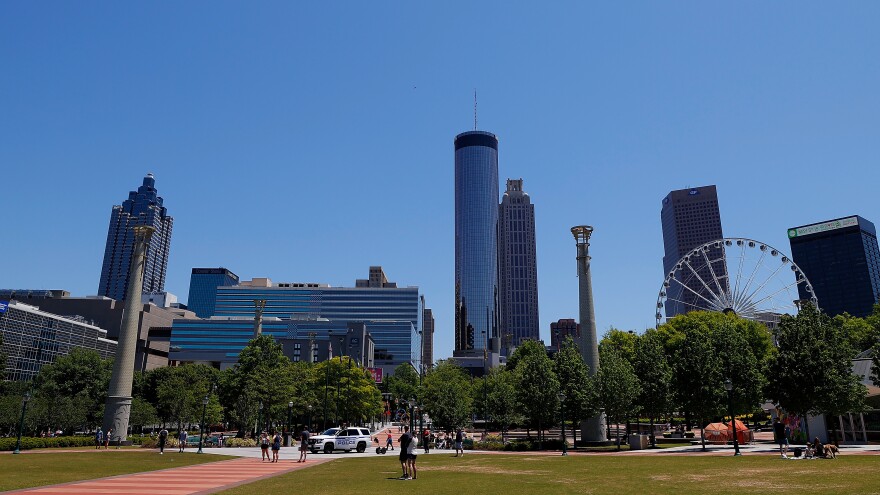Wykeisha Howe is trying to be thrifty. When her kids are uncomfortable in the sweltering Atlanta heat, she gives them freeze pops. Instead of cranking up the air conditioner, she uses a fan. Lunch and dinner are cooked at the same time, so the electric stove doesn't have to be turned on twice.
"I try my best to manage and ration out things as best as possible," she says.
Still, Howe, who has five kids living at home, is about a month and a half behind on her electric bill. For the last four months, the bill didn't need to be a priority. When the coronavirus pandemic hit, her electricity provider, Georgia Power, voluntarily suspended disconnections for nonpayment.
Dozens of states and utilities around the U.S. took similar actions, ensuring that even as businesses closed and millions of Americans lost their jobs, people would still be able to keep their lights on regardless of their ability to pay.
Now, many of those power shut-off moratoriums are expiring, including Georgia Power's, which ended on July 15. And this comes as Americans who are still struggling face the end of another lifeline: supplemental unemployment benefits that are set to lapse.
The combination has utility analysts and advocates for low-income communities worried about a potential "tidal wave" of power shut-offs at a time when temperatures and COVID-19 cases are soaring across much of the country and as health officials are urging people to stay home in response to both emergencies.
Utility groups, energy watchdogs and advocates for those in need are calling for a national moratorium on power shut-offs and are pressing Congress for relief. But the White House and both parties are at odds over what another round of relief money would look like and how much it would be.
"We're looking at this unprecedented wave of need that is coming our way," says Katrina Metzler, executive director of the National Energy and Utility Affordability Coalition. "It's a crisis in the middle of a crisis."
Making matters worse, advocates warn, the people most at risk of losing power are Blacks, Latinos and Native Americans, who are also most at risk of serious harm from COVID-19.
It's unclear how many people face shut-offs, because most states don't require utilities to release information on disconnections or arrearages. The Edison Electric Institute, the trade association for investor-owned utilities, says it's working to get a sense of the scale of the issue, but it's clear that for millions of electric customers, bills are piling up.

Nearly 100,000 Georgia Power customers were two or more months behind on their bills, according to the utility's most recent data. The company, like many utilities, says it wants to work with customers to avoid disconnections. It's offering payment plans to help people with accrued debt and is connecting customers with assistance programs.
"We know this is still a critical time with the pandemic still going on. We want to be flexible with our customers," says Georgia Power spokeswoman Allison Gregoire.
An analysis by the National Rural Electric Cooperative Association, which represents smaller utilities around the country, estimates that by the end of next year, its members will have $2.6 billion in unpaid accounts. Without federal intervention, ratepayers may end up picking up that tab, it says.
The inequality of energy insecurity
Energy insecurity did not start with the pandemic. Roughly 1 in 3 U.S. households had a hard time paying energy bills in 2015, according to the Energy Information Administration. Hispanics and racial minorities were disproportionately affected.
That trend has continued during the pandemic and economic crash.
A nationwide survey in May by the O'Neill School of Public and Environmental Affairs at Indiana University found that 22% of respondents had to reduce or forgo other basic needs, like food or medicine, to pay their energy bill in April. Seventeen percent of those surveyed weren't able to pay their energy bill at all. The rates were much higher for households of color, says Sanya Carley, a professor of public and environmental affairs at the O'Neill School.
"This isn't just an issue of not being able to afford energy," she says. "These issues are so wrapped up into bigger institutional discrimination and biases and other problems, such as housing stock and housing problems."
People of color and immigrants have also been hit harder economically by the pandemic. In early March, Erlila Accius, a resident of Broward County, Fla., who's originally from Haiti, was told not to come into the doctor's office where she worked. Patients were canceling appointments. A month later, the doctor called and said he could not afford to have her on staff anymore.
"I've been applying constantly. Every day I'm on the Internet looking for jobs," she says. "And so far, nothing yet."
Accius says she has been able to keep up with her bills to this point. Her sister has helped out, and the extra $600 in unemployment benefits every week has gone a long way. But those benefits are slated to stop by the end of July, and Accius, a mother of two, says unless something changes, she's not sure how she's going to make ends meet. Florida Power & Light, her electricity provider, says it has not made a final decision on when it's going to resume disconnections for nonpayment and continues to waive late fees and offer payment extensions.
We're looking at this unprecedented wave of need that is coming our way. It's a crisis in the middle of a crisis.
But Accius is still concerned. "I don't know what's going to happen," she says.
Both of her daughters are stuck at home and may be taking classes virtually, meaning higher electric bills in the fall. Then there's the extra money she's spending to keep the air conditioner running. Accius has sickle cell anemia, so turning off the air conditioner would be dangerous to her health.
"When it's hot, you need air conditioning," she says. "If you don't have electricity, if you don't have access to it, how are you going to survive?"
In central Florida, a few utilities have resumed disconnections for nonpayment. The Orlando Utilities Commission is one of them.
Tim Trudell, a spokesman for the municipally owned public utility, says it recently disconnected about 1,400 customers. Almost all of those households, he says, were reconnected soon after.
It was a tough decision, Trudell says. The utility is working with customers to do everything it can to prevent shut-offs. "But at the same time, you've got to run a utility and keep it from going out of business," he says. "It's a tough economy for everybody, our business included."
Heat is a silent killer
Heat is a silent and often overlooked killer, responsible for more deaths than any other weather-related disaster. The Centers for Disease Control and Prevention estimates that more than 600 people in the U.S. die every year from extreme heat.
A recent study by researchers at Boston University and the University of British Columbia suggests the number may actually be far higher, though — possibly as high as 5,600 annually — with even moderate heat waves increasing the number of deaths.
Human-caused climate change is amplifying the risk. Days with extreme heat index conditions, when combined the temperature and humidity reach dangerous levels, could double in the U.S. by midcentury, according to a recent study by researchers with the Union of Concerned Scientists.
Temperatures have already been unusually hot this summer in much of the country. Meteorologists say that 2020 is on track to be one of, if not the, hottest years on record. And federal forecasters are predicting above-average temperatures for most of the U.S. in the coming months.
"We're looking at a really, really awful dynamic where people will be without essential utilities, arguably in the worst time of year for that to happen in the South," says Alfred Ripley, an attorney at the North Carolina Justice Center, a state where as many as 1 million people are behind on their utility bills.
Nearly every state in the country has protections against power shut-offs during the winter months to prevent people from freezing when temperatures dip below a certain point. Far fewer have protections against shut-offs in the summer when it's scorching outside.
"High-temperature protections are much less all embracing, because they're not calendar driven. They're much more episodic," says Charlie Harak, senior attorney for energy and utility issues at the National Consumer Law Center.
Falling through the cracks
Harak and others warn that those holes in long-standing protections — and the expiration of newer pandemic-related protections — mean it's a matter of time before people start falling through the cracks.

"We are just beginning to see the tip of the iceberg of what the demand is out there and the unmet need as far as utility assistance is concerned," says Michael J. Bradford, director of the Project SHARE program at the Georgia division of the Salvation Army.
Congress provided $900 million in utility-related funding for low-income households in one of its relief packages. Energy watchdogs, consumer advocates and utilities are asking for more, and some of them say Washington needs to act fast.
West Atlanta resident Harriet Feggins has a 13-year-old daughter who relies on a machine to help with her asthma. Feggins has been out of work since March because of the pandemic. She has managed to pay her electric bill by dipping into her 401(k) and scraping together odd jobs — watching the kids of essential workers and cleaning homes. She has shut off the power in parts of her home and has hung blackout curtains to try to keep the house cool and her electric bill low.
A community group is trying to set her up with a federal program that provides utility bill assistance. But she's not sure if it will come through, or when.
Until then, she says, "every little change and money I get I'll put towards my Georgia Power bill, because we can't be in the dark."
Copyright 2021 NPR. To see more, visit https://www.npr.org.





